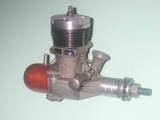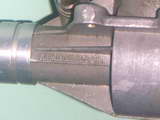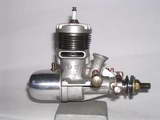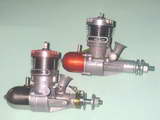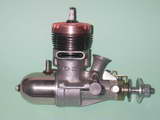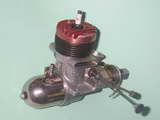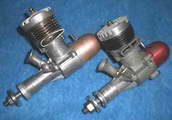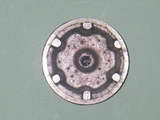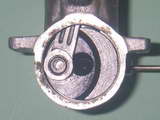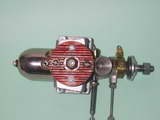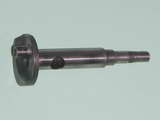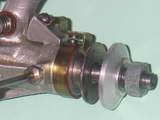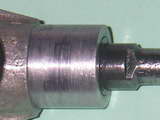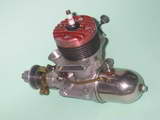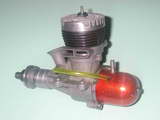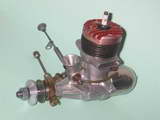A Forgotten OS Design:
The 29 Twin-stack Ignition Model
by Adrian Duncan
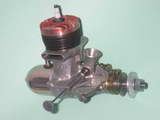 |
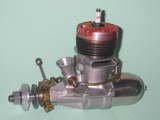 |
|
| Click on images to view larger picture. | ||
Most aficionados of classic model aero engines are doubtless familiar with the series of radially-ported twin-stack glow-plug models that were introduced by the O.S. company of Osaka, Japan beginning in 1949. There were two successive variants of the .29 cu. in. version of this design, as well as an .099 cu. in. model and a .36 cu. in. unit that was specifically targeted at the American market. The various O.S. twin-stack models formed a major component of the company lineup from 1949 until 1954, when the new loop-scavenged O.S. Max series first appeared. (O.S. 29 TS-3—O.S. New .36)
At the time of their conception, the twin-stack O.S. models represented a significant departure from the design course which had previously been steered by O.S. designer Shigeo Ogawa. In fact, by then-contemporary Japanese standards they were very radical designs indeed. The question of how this very different design approach came about has always exercised students of Japanese model engine history.
When compared with other contemporary Japanese productions, it's undeniable that the O.S. twin-stack models have a somewhat "un-Japanese" style about them. Japanese design thinking at the time in question was very functionally oriented, with a distinctly minimalist slant—only those features which contributed to efficient operation were generally included. Some features of the O.S. twin-stack models appear to run directly counter to this philosophy in that they seem unnecessary from a functional standpoint (for example, you don't need twin stacks on a radially-ported engine!) and appear to be based more on "artistic" considerations. The engines certainly display a more exotic style than most of their rather utilitarian Japanese counterparts.
Accordingly, we might legitimately suspect some kind of external influence in the development of the O.S. twin-stack designs. In considering possible sources of such influence, one credible candidate is undoubtedly the legendary Bill Atwood. It's long been known that Atwood had a hand in the marketing of these designs in the USA, and the Atwood name actually appeared cast in relief onto the cases of the 1953 "New.36" model, which was specifically aimed at the US market.
Most of the preceding information is of course common knowledge among model engine enthusiasts. What appears to be far less well known is the fact that these glow-plug models were actually preceded in 1948 by a twin-stack .29 cu. in. spark ignition design. This original twin-stack variant has remained more or less anonymous over the years because it was made in very small numbers indeed—so small in fact that it was omitted from the well-known 40th anniversary model summary leaflet prepared by the company in 1976. It is also missing from the list of past O.S. products currently to be found on the O.S. website.
Nonetheless, the engine does undoubtedly exist, as witness the fine example in my own possession as well as several others known to be in the hands of Japanese collectors. My example bears the serial number 145, and I am also in contact with engine number 49 of the same type. It thus appears certain that the serial numbering sequence started from 1 and that at least 145 examples were made.
My own example formerly belonged to the late Clarence Bull of BY&O propeller fame. Clarence had reportedly had the motor for many years, and I'm extremely grateful to my friend Mike Conner for providing me with the opportunity to acquire this very rare engine!
Apart from the obvious presence of a timer, the most immediately observable difference between the spark ignition version of the twin-stack O.S. 29 and the later glow models is that the sparker is based upon a sand-cast crankcase as opposed to the die-cast units employed on all of the subsequent twin-stackers. The twin exhaust stacks on the sand-cast case were cast solid and then milled out internally. They are missing the internal bracing pillar that was a feature of the stacks on the later die-cast glow models. The mounting holes are drilled in an identical pattern to those of the later die-cast models, so the sparker will drop right into a model built for a die-cast motor and vice versa. The "twin bump" style of mounting lugs is also identical on both models.
Another visible difference is the fact that the sparker has a screw-in backplate as opposed to the bolt-on component employed on the subsequent glow versions. Finally, the tank of the spark ignition model is plated rather than being color-anodized.
Upon first examining the motor, it was immediately clear that this was something different and inquiries were definitely in order. The appearance of the O.S. name cast intaglio into the right-hand side of the main casting confirmed the engine's claim to be an O.S. product, even if the design itself had not already done so.
Contacts with friends and colleagues in Japan yielded the information that this is a recognized O.S. model among Japanese collectors although it is extremely rare today even in Japan and little is known of its origins. The word on the street among old-timers in Japan is that at most some 200 examples of this sand-cast spark ignition model were produced in 1948 as a prelude to the decision being taken to enter into series production of the die-cast glow-plug version in 1949. Basically, the sand-cast spark ignition model is viewed in Japan as having served as a test-bed for the generic O.S. twin-stack design.
The engine is encountered with both plain and red-anodized cylinder heads. Japanese sources speculated that the red-anodized head may have been a high-compression option. However, the checked compression ratio of my own red-anodized example is a very modest 6.5 to 1, which is a perfectly appropriate figure for a general-purpose spark ignition engine but hardly supports the high-compression theory! It seems more likely that the heads are identical and the red anodizing was introduced on a batch of the later examples purely as a cosmetic improvement.
The motor has the standard O.S. 29 twin-stack bore and stroke of 18.8 mm and 17.3 mm respectively for a displacement of 4.80 cc (.293 cu. in.). It weighs in at 9 1/8 ounces (259 gm) with tank and plug—pretty hefty, and that's without the batteries and coil! Like all O.S. products then and now, the engine is extremely well-made, especially where it counts. All fits are beyond reproach.
The fuel line is the ubiquitous 2 mm brass item typical of those used on many Japanese engines of this vintage. The needle valve assembly with its externally-threaded needle is also typical of contemporary Japanese practice. It is fitted with a flexible extension and a locating clip that could be bent to fit over the rear mounting hole or be attached with a screw to the airframe. A simple coil spring is used to retain settings.
We noted above that unlike the later glow models, the backplate is a screw-in item which is machined from a sand-casting. The interesting side observation may be made at this point that when the Japanese Boxer company released their glow .29 cu. in. twin-stack glow-plug model, which gives the appearance of having been closely modeled on the O.S. 29 albeit with somewhat more "Japanese" styling, they used a screw-in backplate of similar pattern to that seen on the spark-ignition O.S. 29 twin-stack. It's actually possible that the Boxer glow model preceded the 1949 O.S. glow version—we don't know for sure.
Although I normally don't dismantle any engine unnecessarily, especially one of this rarity, I felt that the search for knowledge left me no option in this case! So out came the tools, and soon all was revealed.
Following the removal of the fuel system, the next step was to unscrew the very substantial sand-cast backplate. This revealed a crankweb that appeared very similar to that of the later glow models. The cast alloy rod is clearly different, though—it is a very sturdy item with cast-in webs at the rear and a bronze bushing at the big end. A lot of hand-work appears to have been done to finish it after casting.
The cylinder assembly is retained by two screws only which pass through the sand-cast head and integrally-formed steel cylinder cooling fins to engage with tapped holes located fore and aft in the case. There are two additional screws at the top to help to retain the cylinder head. These thread directly into the upper flange of the steel cylinder. A nice touch is the fact that all four screws have locking washers installed under their heads. I removed all screws but left the head in place since it seemed to be well "stuck" on and I didn't want to break a good seal. The screws have a rather oddball metric thread of 3 mm x 0.65 mm—a slightly coarser thread than standard 3 mm items. I'd best not lose them!!
The cylinder arrangement is more or less identical to that used later on the die-cast twin-stack 29 glow models. The exhaust port flange sits on a recessed shelf machined into the upper crankcase casting just below the lower edge of the twin stacks. A seal is ensured through the use of a fairly thick gasket. There are two pairs of exhaust ports on either side, each pair feeding into one of the two stacks. The paired transfer ports are located directly below the exhaust ports. They are fed by two bypass passages cast into the crankcase, one on each side. Unlike the later glow models, the steel cylinder and integral cooling fins of the sparker are left in their natural state rather than being blued.
The very heavy counterbalance on the crankweb necessitates the use of an asymmetrical rod. As can be seen in the side view of the rod, the actual rod column is located well to the rear of the big end bearing centre. The big end is bronze bushed and the small end is of very generous length, occupying most of the exposed width of the gudgeon pin within the piston.
The piston has a conical top with no deflector, matching the plain conical configuration of the underside of the cylinder head. Unlike the pistons of the later .29 and .36 cu. in. glow models, which used a separate gudgeon pin carrier riveted into the piston interior through the piston crown, the sparker employs a conventional fully floating gudgeon pin mounted in bosses formed integrally with the piston in the conventional manner. The gudgeon pin itself is a tubular steel item having brass end pads. The piston walls are rather thin and there is no increase in wall thickness at the boss locations. As a result, the bearing length for the gudgeon pin ends in the bosses is minimal, to the point where this may legitimately be considered a design weakness in my personal view.
The crankshaft is generally similar to that of the later glow model apart from the fact that it has a far shorter "flat" machined into it for the steel prop driver, which also incorporates the timer cam. The use of a steel prop driver doubtless made it practical to use a shorter locating flat without risk of stripping the corresponding key in the prop driver. The crankshaft main journal diameter is 11 mm, with an 8 mm internal gas passage. The round induction port in the shaft is also 8 mm in diameter.
The prop-nut thread on the crankshaft was originally 7 mm, but unfortunately on this example a previous owner has re-cut most of the thread to 6 mm. This rather botched effort can be seen on the image of the crankshaft. Fortunately, it doesn't affect the engine's appearance or functionality in any way.
By far the oddest feature of this model is the timer design employed. As can be seen in the images, the timer is a simple leaf-spring open-frame device of a type that had been abandoned by O.S. and others for a considerable time prior to 1948, when the twin-stack sparker was reportedly (and logically) made. The company's founder and chief engine designer Shigeo Ogawa had begun using enclosed timers as early as 1943, and a number of O.S. models introduced after WW2 had featured such devices. Although very well executed with a sturdy cast frame, the type of timer fitted to the twin-stack spark ignition model presently under discussion is rather rudimentary and would almost certainly have represented an impediment to the extraction of maximum performance. The point gap, for instance, is not readily adjustable. The sole advantage of this unit is its ease of maintenance—everything is exposed for convenient cleaning.
We might suppose that perhaps Ogawa-san just liked the retro look of that timer style and appreciated its maintenance advantage. That is certainly a possibility, albeit in my view rather unlikely and certainly very "un-Japanese". Another possibility of course is that my Japanese colleagues have their dates wrong and the engine actually dates from well prior to 1948. This again seems highly unlikely—the engine bears no design resemblance whatsoever to any of Ogawa's pre-war and wartime designs. There's no doubt that it is best seen as a direct precursor of the twin-stack glow models which began appearing in 1949, and this is completely consistent with the reported 1948 date noted above.
This being the case, we must look for an answer to the timer question that has some basis in terms of practical considerations and fits the surrounding circumstances. A good start appeared to be to wade through the various publications on model engines which included illustrations of the timers of a variety of engines to see if any external design influences were apparent.
This was an imposing task for someone who is not an expert on spark-ignition engines, and to improve my odds of narrowing it down I started with Tim Dannel's invaluable "American Model Engine Encyclopaedia" and went straight to the Atwood section in view of the known connection. Eureka—hole in one!! There it was—the timers depicted in the illustrations of the 1938 Atwood Phantom and Hi-Speed models (page 11) and 1940 Phantom Bullet (page 12) bore an unmistakable "family" resemblance to the timer on the O.S. .29 model with which we are dealing! The shape of the frame casting is slightly different (presumably to accommodate the sloping downdraft carburettor used on the O.S. model), but the general construction and principle of operation are identical. Even the prop driver looks very similar.
Suddenly, things began to fall into place!! The implication is that the source of the very "agricultural" timer was none other than Bill Atwood! This is completely consistent with the previously-known fact that Atwood had a connection with the O.S. twin-stack series. It now seems that Atwood may have become involved with the O.S. twin-stack project at an even earlier stage than had been suspected and may well have had a significant influence on the basic design of this model going right back to its initial spark-ignition configuration. It's difficult to explain the use of the Phantom-style timer on the spark-ignition prototypes in any other way. Indeed, Atwood may have even been the instigator and promoter of the overall engine design.
Some support for this notion may be found in certain measurements taken from the timer itself. Most significantly, it's mounted on a machined boss having a diameter of 0.625 in exactly—very Atwood-like indeed, with nothing metric about it! However, the threads used for the timer assembly screws are very odd indeed—they appear to be metric but are neither standard metric nor any standard US thread that I've encountered. As an example, the timer arm thread has an O/D of 0.090 in (2.30 mm) and a pitch of .55 mm (46.2 tpi) which is a case of close but no cigar to a 3-48 (.099 in. x 48 tpi). A 3-48 nut "rattles" on the timer arm and is a definite misfit—it would strip if tightened. I've never heard of a 2.3 mm x .55 metric thread—has anyone else??
The assembly screws for the timer measure up at 3 mm x .65 (0.118 in. x 39.07 tpi)—another non-standard metric thread which is a close approximation of a 4-40 thread (0.112 in. x 40 tpi) but doesn't work with a 4-40 nut—the nut tightens up well before the thread makes it through. As noted previously, the cylinder hold-down screws are of that same 3 mm x .65 thread—they do not fit into 4-40 holes, and 4-40 screws rattle about in the tapped holes in the case and would strip for sure if tightened. This stuff certainly has me puzzled!
The best practical scenario that I've been able to come up with to explain all of this (and it's pure speculation based on circumstances, I freely admit) has Ogawa and Atwood in 1947 discussing the possibility of Atwood assisting in the marketing of a suitable introductory O.S. product in the USA. It's worth recalling at this point that O.S. had in fact succeeded in selling a few engines in the USA prior to WW2 getting in the way. So this scenario would have made perfect sense in the context of an attempt by Ogawa to resume a commercial activity that had been rudely interrupted by the war. And we already know that Atwood did assist Ogawa on the post-war marketing side in the USA. So far, so good...
At the time in question the US market was well supplied with excellent domestic engines (by Atwood himself, among others) in the larger displacements on which Ogawa had focused following the war. The emerging trend was in the direction of smaller engines, and Atwood may have suggested that Ogawa would do better to try something a little smaller. He certainly wouldn't have suggested a design that would compete with his own offerings!
Inevitably, the very popular .29 displacement category would have come up. But even this category was well supplied domestically in the USA, albeit not at the time by Atwood, and the latter may well have suggested that Ogawa needed something visually "different" with which to woo the US consumer. The strikingly artistic twin-stack .29 cu. in. design could well have resulted from such discussions. There's no way of knowing whether Atwood or Ogawa was the primary designer—there are objections to both possibilities. But someone undoubtedly came up with the twin-stack concept, and Ogawa undeniably ended up producing a series of such engines.
I think the most probable (but currently unsubstantiated) explanation for the undoubted existence of this engine is an agreement between Atwood and Ogawa to collaborate in the manufacture of a short run of such engines on mutually-agreed design lines and then to try them out on a sample of their intended customers both in Japan and in the USA. This may well be how Clarence Bull came to own the example that now resides in my own collection. The extent of any collaboration that may have taken place in connection with the actual manufacturing is unclear, but it seems likely that Atwood supplied the timer components at least.
It might be asked why Ogawa would sit still for the use of such an antiquated timer on the newly-conceived twin-stack wunderwerk that bore his company's name. It seems probable that he saw this engine as more of a test piece than a production model in the true sense. This would explain its omission from the company's subsequent listings of their commercial products. In addition, Ogawa may well have seen it as an Atwood initiative rather than his own and hence been content to let Atwood fit whatever timer he liked. If the engine failed in consequence, that would reflect on Atwood rather than Ogawa.
The possibility actually exists that Ogawa was not personally all that taken with this rather "un-Japanese" design but was in effect talked into giving it a try by Atwood, perhaps as the price of Atwood's co-operation on the marketing side. If this was the case, Ogawa may not have worried too much about whether or not the engine was a success—he had no immediate plans to produce it or promote it in any case.
In the latter context, Ogawa most likely foresaw that any production model which might result would use glow-plug ignition but was stymied for prototype testing purposes by a chronic unavailability in Japan of suitable glow-plugs. It must be recalled that at the time in question platinum-iridium wire for making glow-plugs was in the unobtanium category in Japan—whatever was available came from American service personnel like Jerry Asner, who supplied wire to Enya and Fuji and later became Enya's first US distributor.
In addition, Ogawa was a bit out of the mainstream anyway down in Osaka and might have had trouble accessing any glow-plugs that were available. So at the time of which we're speaking, the use of glow-plug ignition for the test prototype series might have been a bit of a problem for him (although that certainly changed later).
This view is supported by the fact that all of the other O.S. models being produced as of 1948 were still spark ignition units. However, as of 1948 the other O.S. spark ignition models with their up-to-date enclosed timers were all much large engines in the .60 cu. in neighborhood, and the timers used on those models would not readily fit the smaller model now envisioned. The same was true of Atwood's then-current productions.
This would have created a bit of a dilemma for the design team. As of 1948 the glow-plug had definitely arrived in the USA, and it's highly probable that neither Atwood nor Ogawa saw any long-term future for the use of spark ignition. This being the case, they would be understandably reluctant to go to the trouble of developing a new purpose-built .29-size timer. Indeed, Atwood was already poised to move into the glow-plug era with the 1948 Glo-Devil version of his .63 cu. in. Super Champion design as well as glow versions of his new Triumph models.
However, Atwood had a solution to the problem at hand—use a slightly modified version of the old Phantom 29 timer with which he was so familiar. Although he no longer made .29 cu. in spark ignition engines and would have been just as reluctant as Ogawa to develop a new timer for a short-run test series, he probably still had a lot of the required components from the old Phantom series lying about. Moreover, he had extensive experience in making these things work.
So the decision was taken to fit what amounted to left-over old-tech timers that Atwood already had lying about to what appears to have been no more than a short-run and un-promoted test series of engines. If this scenario is correct, the likely expectation was that if the design looked promising Ogawa could then go to the expense of making dies and committing himself to a die-cast glow version once the plug supply situation had become less of an issue. This is in fact what occurred in 1949.
Having gone through the above scenario in detail, it's necessary to repeat once more that all of this is purely speculative at present and is based entirely upon circumstantial evidence—we would need far more hard evidence before we could claim any of it as fact. We'd welcome any alternative scenarios from readers that are supported by other evidence or fit the above circumstances equally well.
One objection that we ourselves can set against the above hypothesis is the seeming improbability of Atwood coming up with a design concept that was so far removed from his own previous design thinking. All of his earlier designs had been deeply rooted in then-current American design thinking, albeit with some interesting twists on the induction theme. Still, there are objections regardless of whom one credits with the design. And the fact remains that someone undoubtedly did come up with it—choose your favorite!!
There's no doubt at all that the engine would run with the timer as fitted—the unit is both very well made and quite sturdy, with a very strong spring. The likely effect of this timer design would be to limit the maximum operating speed of the engine. For a spark ignition design with its adjustable timing and consequent operating flexibility, low and moderate speed running presents no insuperable obstacle and it's undeniably true that the rather low compression ratio implies that the intended peak operating speed was not high. There were undoubtedly better timer concepts available had the designers wished to use them, but perhaps they simply wanted to check out the basic design of the engine before putting it into large-scale production and just used what was readily available. We'll probably never know for sure—but there must surely be some practically-founded explanation of this odd feature.
However it came about, this is certainly one of the more intriguing and least-known O.S. designs from the early post-war period! Might try giving it a run sometime, just to see if that timer actually works!
Acknowledgement
Before signing off on this topic, I'd like to acknowledge the assistance of my valued friend and colleague Alan Strutt in the preparation of this article. While I accept full personal responsibility for all of the data and interpretations set out above, I have relied very much on Alan to read through what I've written and challenge my conclusions every step of the way. Alan also supplied the Boxer image included above. Any merit which this article may possess owes much to Alan's open and always objective criticisms. Thanks, mate!!
This page designed to look best when using anything but IE!
Please submit all questions and comments to
[email protected]
|
Unless otherwise expressed, all original text, drawings, and photographs created by
Ronald A Chernich appearing on the Model Engine News web site are licensed under a Creative Commons Attribution-Noncommercial-Share Alike 3.0 License. |

|
